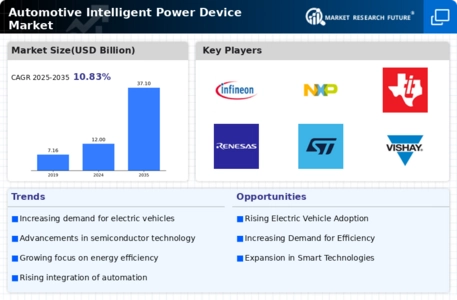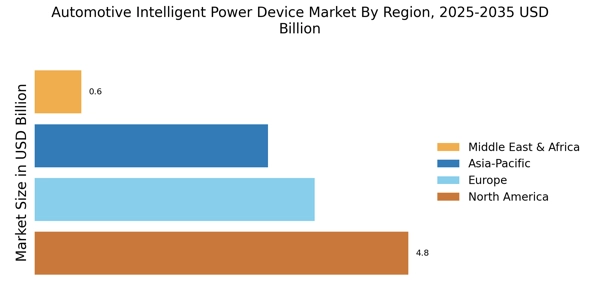Focus on Energy Efficiency
Energy efficiency remains a critical driver within the Automotive Intelligent Power Device Market. As automotive manufacturers strive to reduce energy consumption and enhance vehicle range, the demand for intelligent power devices that optimize energy use is escalating. Recent studies indicate that vehicles equipped with advanced power management systems can achieve up to 20% greater energy efficiency compared to traditional systems. This improvement not only benefits consumers through reduced fuel costs but also aligns with global sustainability goals. The integration of energy-efficient power devices is becoming a standard requirement, thereby fostering innovation and competition among manufacturers in the Automotive Intelligent Power Device Market.
Shift Towards Electrification
The Automotive Intelligent Power Device Market is experiencing a pronounced shift towards electrification, driven by the increasing demand for electric vehicles (EVs). This transition is largely influenced by stringent emissions regulations and consumer preferences for sustainable transportation solutions. As of 2025, the market for electric vehicles is projected to grow significantly, with estimates suggesting that EVs could account for over 30% of total vehicle sales. This surge in demand necessitates advanced power devices that can efficiently manage energy distribution and enhance vehicle performance. Consequently, manufacturers are investing in innovative power devices that support higher voltage levels and improved thermal management, thereby propelling the growth of the Automotive Intelligent Power Device Market.
Integration of Smart Technologies
The integration of smart technologies into vehicles is reshaping the Automotive Intelligent Power Device Market. With the advent of connected vehicles, there is a growing need for power devices that can support advanced functionalities such as real-time data processing and vehicle-to-everything (V2X) communication. These technologies require sophisticated power management solutions to ensure reliability and efficiency. As of 2025, the market for connected vehicles is expected to expand rapidly, with projections indicating that nearly 50% of new vehicles will be equipped with some form of connectivity. This trend necessitates the development of intelligent power devices that can seamlessly integrate with these smart systems, thereby driving growth in the Automotive Intelligent Power Device Market.
Government Initiatives and Incentives
Government initiatives and incentives aimed at promoting electric and hybrid vehicles are playing a pivotal role in shaping the Automotive Intelligent Power Device Market. Various countries are implementing policies that encourage the adoption of cleaner technologies, including tax rebates, subsidies, and infrastructure development for EV charging stations. These initiatives are expected to stimulate market growth, as they lower the barriers to entry for consumers considering electric vehicles. As of 2025, it is anticipated that such government support will lead to a substantial increase in the adoption of intelligent power devices, which are essential for the efficient operation of electric and hybrid vehicles. This supportive regulatory environment is likely to foster innovation and investment in the Automotive Intelligent Power Device Market.
Rising Demand for Advanced Driver Assistance Systems (ADAS)
The rising demand for Advanced Driver Assistance Systems (ADAS) is significantly influencing the Automotive Intelligent Power Device Market. As safety regulations become more stringent and consumer awareness of vehicle safety increases, manufacturers are compelled to incorporate ADAS features into their vehicles. These systems rely heavily on intelligent power devices to function effectively, as they require precise energy management to support various sensors and processing units. The market for ADAS is projected to grow at a compound annual growth rate (CAGR) of over 15% through 2025, indicating a robust demand for power devices that can enhance the performance and reliability of these systems. This trend is likely to propel innovation within the Automotive Intelligent Power Device Market.
















Leave a Comment